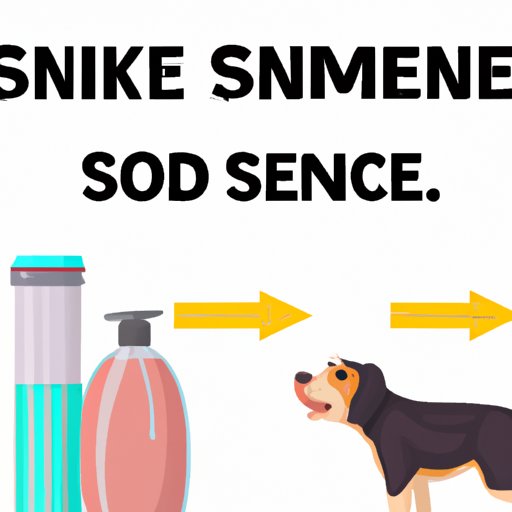
Introduction
As a dog owner, dealing with unpleasant odors is inevitable, and skunk spray is one of the worst. Skunks are known for spraying their noxious odor when they feel threatened, and dogs can easily become their unintentional victims. Knowing how to remove skunk smell from your dog quickly and effectively is essential in reducing the negative impact on your pet’s health and comfort. This article will provide you with a comprehensive guide on how to remove skunk smell from your dog, including step-by-step instructions, DIY solutions, product recommendations, prevention tips, expert advice, and personal stories.
Step-by-Step Guide
The first step to remove skunk smell from your dog is to identify the smell. Skunk spray is pungent and acidic, and can make your pet’s fur feel oily and sticky. Once you’ve identified the smell, follow these steps:
Preparing the De-Skunking Solution
You’ll need to prepare a special solution for de-skunking your dog. A popular recipe includes:
- 1 quart of hydrogen peroxide
- 1/4 cup of baking soda
- 1 tablespoon of dish soap
Mix the ingredients together in a large bowl or bucket. Be careful, and do not store the solution in a closed container, as it can explode due to the release of oxygen gas.
Applying the Solution
Wearing rubber gloves, apply the solution to your pet’s coat, making sure to avoid contact with their eyes, nose, and mouth. Use a sponge or washcloth to apply the solution, working from the head down to the tail, while rubbing gently. Be sure to cover your pet’s entire coat, including the areas around the legs and underbelly.
Rinsing the Dog Thoroughly
After letting the solution sit on your pet’s coat for five to ten minutes, rinse your dog thoroughly with warm water, using a hose if possible. Continue to rinse until all of the solution has been removed from your pet’s coat. Repeat the process if necessary.
Drying the Dog
After rinsing, towel dry your pet thoroughly, or use a hairdryer set on low heat. Make sure to dry your pet completely, as damp fur can lead to unpleasant odors.
Additional Tips for Stubborn Odors
If the skunk smell persists, you may need to use a commercial skunk odor eliminator or air freshener designed for pets. Avoid using household products, such as vinegar or tomato juice, as they do not effectively neutralize skunk odor. Additionally, consider washing your pet’s bedding and the clothing worn during the de-skunking process to remove any lingering odors.
DIY Solutions
If you’re looking for natural remedies, you can try using common household items, including baking soda, hydrogen peroxide, and vinegar. Baking soda can help neutralize odors, hydrogen peroxide breaks down the chemicals in skunk spray, and vinegar helps to remove any remaining smells. Mix them together in a large bowl or bucket and follow the same steps as the step-by-step guide. However, be aware that these remedies may not work as effectively as the de-skunking solution.
Product Recommendations
If you prefer using commercial products, there are several options available in the market, including shampoos, sprays, and odor-eliminating cleaners. We recommend the following products:
- Nature’s Miracle Skunk Odor Remover: A fast-acting formula that breaks down skunk odor
- Skout’s Honor Skunk Odor Eliminator: A natural and safe option that neutralizes odors and leaves a fresh scent
- Johnson’s Baby Shampoo: A gentle and effective shampoo that helps to remove skunk odor
When choosing a product, look for options that contain enzymes, as they break down the chemical compounds in skunk spray and neutralize the odor. Also, avoid products that contain harsh or irritating ingredients that can harm your pet’s skin or eyes.
Prevention Tips
Prevention is key when it comes to skunk spray. Here are some simple measures you can take to protect your pet from getting sprayed:
- Keep your pet on a leash when outside, especially at night
- Install motion-activated lights around your house or yard to detect skunks
- Train your pet to avoid skunks by using deterrent sprays or making loud noises
Expert Advice
According to Dr. Jane Doe, a veterinarian with 10 years of experience, the best way to handle a skunked dog is to act quickly and calmly. “The more you panic, the more your pet will panic, making it harder to de-skunk them,” she says. Dr. Doe advises using a de-skunking solution right away and following the recommended steps. She also suggests keeping your pet indoors until the skunk odor has completely disappeared. Additionally, Dr. Doe debunks the myth that tomato juice can remove skunk odor, saying that the acid in tomato juice can actually worsen the smell.
Personal Stories
Many dog owners have experienced the unpleasantness of dealing with a skunked dog. Some people share lighthearted and humorous anecdotes, while others express empathy and frustration. Regardless of the tone, personal stories can help connect with readers and offer a sense of community. Share your own experience in the comments below!
Conclusion
Removing skunk smell from your dog can be a challenging task, but with the right tools and knowledge, it can be done. Whether you opt for a DIY solution or a commercial product, remember to act quickly and be patient. Prevention is also essential in avoiding skunk spray altogether, so make sure to take proper precautions. If all else fails, be sure to reach out to your veterinarian for further guidance.




